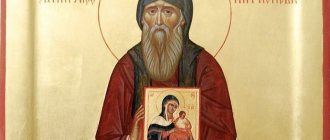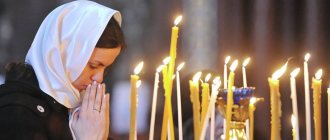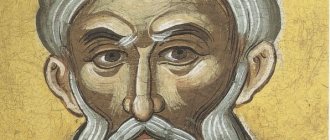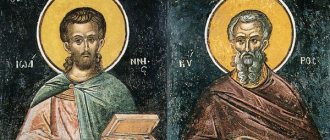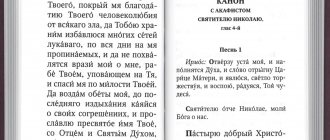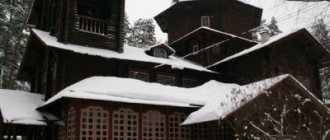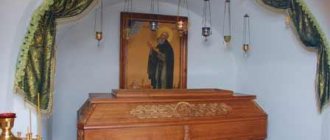Memorial Day: March 21 (April 3)
Reverend Seraphim Vyritsky (in the world Muravyov Vasily Nikolaevich) was born into a strong Christian family, in the Yaroslavl province, in the village of Vakhromeevo, on March 31, 1866. The boy’s parents, Nikolai Ivanovich Muravyov, Khionia Alimpevna Muravyova, being pious people, sought to instill love for God and their son.
The name Vasily was given to him at Baptism on April 1, 1866, in honor of St. Basil the New. He received his first lessons in spiritual and moral education from his parents. It is reported that from childhood he displayed such human qualities as diligence and patience, hard work and perseverance. Vasily mastered general literacy early. His first books were the Psalter and the Holy Gospel.
In his youth he read the Lives of the Saints. The story of the life of Christ and the apostles, the story of the life of the great ascetics deeply impressed and touched the youthful heart. From that time on, a desire arose in him to devote his life to monastic achievement. True, until time this desire remained hidden from others.
Vasily's parents were known as economic people. But this did not prevent them from carrying out Christian work. On Sundays, the family regularly attended services. In addition, fulfilling the Divine commandment to love one’s neighbor, the Muravyovs helped those in need with food and shelter. Whenever possible, their family made pilgrimages to holy places. They were also in the Holy Trinity Sergius Lavra, where the famous elder Barnabas (Merkulov) then labored. His teachings found fertile soil in Vasily’s heart.
But then grief came to the family. At the fortieth year of his life, Vasily’s father died. And he had no choice but to take care of his family into his own hands. And he, a ten-year-old child, taking advantage of the offer of a fellow villager who worked as a clerk in one of the commercial shops in St. Petersburg, went to work. His mother blessed him for the journey with an icon.
Through the efforts of a fellow villager, Vasily received the position of delivery boy at one of the shops of Gostiny Dvor. He worked diligently, and this attitude towards work did not go without due recognition. Over time, he was entrusted with more and more complex and responsible cases. With the help of God, he did not let down those who trusted him, returning good for good. He sent a significant part of the money he earned to his mother, who at that time was suffering not only from grief, but also from illness.
By the age of seventeen, Vasily had risen to the rank of senior clerk in the Gostiny Dvor shop, and at twenty-six he organized his own business. Subsequently, he became one of the most successful fur traders in Russia, supplying goods even abroad. His hard work and determination showed.
Entrepreneurship required dedication from Vasily, but while he devoted himself to commerce, he did not forget about God and his long-standing desire to join monasticism: he prayed a lot, visited church, when he needed to travel on trade business to different parts of the country, he, if possible, tried to visit saints places. On occasion he visited his mother.
They say that for a certain time, in his youth, Elder Barnabas blessed him to live in the world. Understanding Divine Providence, the ascetic noticed to Vasily that for now he must live like an ordinary person, fulfill the will of God, remaining in the world; he must start a family, and he will accept monasticism when God pleases.
At the age of twenty-four, Vasily was united in marriage with Olga Ivanovna Netronina. Their relationship was built on mutual love and mutual understanding. In 1895, the first-born, Nikolai, was born into their family, and after some time a daughter, Olga. About a year later the girl died. Then, by common decision and agreement, with the blessing of Elder Barnabas, they began to live like brother and sister and began to prepare themselves for the future monastic life.
Often the sick and poor people became guests of the spouses. The Muravyovs donated quite a lot of money to almshouses and church needs (for example, one of their donations amounted to forty thousand rubles!).
In 1903, when celebrations took place regarding the glorification of Seraphim of Sarov, Vasily and Olga were present at this celebration.
In 1905, Vasily Nikolaevich became a member of one of the largest charitable organizations in Russia - the Yaroslavl Charitable Society. It is appropriate to note that Saint John of Kronstadt was also a participant in this society. In 1908, its ranks were joined by His Eminence Tikhon, who headed the Yaroslavl See (later the Patriarch).
In 1906, Vasily’s spiritual mentor, Elder Barnabas, reposed in the Lord. V. Muravyov was able to see him before his death, when he visited St. Petersburg.
Until 1917, Vasily Nikolaevich provided material support to the Church. But when chaos and unrest came along with the revolution, he lost his trading business and his former means. Thousands of people who did not fit into the contours of the new society were forced to flee abroad. During this period, Vasily lost many friends. Along with the persecution of capital and the construction of a “new world,” persecution for faith began. Bloody reprisals against the clergy followed. Vasily Nikolaevich had the opportunity to go into exile. But he didn't want to.
The year was 1920. During this difficult period, V. Muravyov decided to join the brethren of the Holy Trinity Sergius Lavra. But God's Providence decreed otherwise. Metropolitan Veniamin of Petrograd and Gdov blessed him to take monastic vows at the Alexander Nevsky Lavra. On October 29, 1920, he was tonsured, and Vasily received the new name Barnabas, in honor of his spiritual mentor, Barnabas of Gethsemane. Around this time, Vasily's wife, Olga, entered monasticism at the Resurrection Novodevichy Monastery, with the name Christina.
Soon Barnabas was ordained a hierodeacon. It was a terrible time, people died in huge numbers. During this period, he carried out one of the most difficult obediences - he was in charge of the cemetery office. Secular authorities constantly intervened in the affairs of the monastery with instructions and claims, but, surprisingly, monastic life in the Lavra not only did not fade away, but also had an extraordinary spiritual upsurge.
In 1921, on September 11, Metropolitan Benjamin ordained Father Barnabas as a hieromonk. Along with his pastoral activities, he also dealt with economic issues related to household needs. Here his previous entrepreneurial experience came in handy.
The year 1922 was marked by serious internal difficulties for the Lavra. In July, the self-saint Nikolai Sobolev, the Renovationist archbishop, appeared at the Lavra and demanded that the leadership of the monastery be transferred under his omophorion. At the same time, he resolutely forbade raising the name of Patriarch Tikhon during worship.
Well aware that direct and open opposition to the Renovationists, who had support from the secular authorities, could lead the Lavra to disastrous consequences, Archimandrite Joasaph, the then head of the monastery, considered it best to resort to a compromise: formally recognize the power of the Renovationists and stop commemorating the name of the Patriarch who disgusted them during divine services. , but at the same time maintain the actual management of the monastery and protect its life from renovationist innovations.
Some of the brethren supported this decision, but some did not. The threat of a split loomed. To get out of this situation, Hieromonk Varnava, together with Archimandrite Sergius (spiritual father of the monastery) and Hieromonk Varlaam, called on the brethren to accept external concessions. Their admonition was effective, and over time, their rightness became obvious. After the release of St. Tikhon, in 1923, the Lavra returned to patriarchal authority.
Seeing the conscientious fulfillment of the duties of pastoral and monastic service by Father Barnabas, the brethren elected him a member of the Spiritual Council; then he was entrusted with the post of treasurer.
Around 1926-27, Father Barnabas put on the great schema and received a new name - Seraphim, in honor of Seraphim of Sarov. Soon, at a general meeting of the monastery, he was elected spiritual leader of the Lavra.
They say that in 1927, Father Seraphim predicted Archbishop Alexy (Simansky) future consecration to the Patriarch. The gift of foresight was more than once manifested in Father Seraphim in relation to other people, including ordinary people, who sought his advice and blessing. In addition, he announced the coming intensification of persecution of the Church, which is exactly what happened.
After three years of serving as confessor, Father Seraphim’s health seriously deteriorated. Long stays in the cold and standing on the icy floor during services took their toll. For some time he tried to hide his illness and continued to fulfill his pastoral duties. Meanwhile, his health condition worsened. And one day he couldn’t even get out of bed.
In 1930, with the blessing of Metropolitan Seraphim (Chichagov), he moved to live and serve in Vyritsa. The climate there was better suited to his frail condition. Together with him, also with the blessing of the Metropolitan, schema-nun Seraphima (Olga Ivanovna Muravyova) and twelve-year-old novice Margarita, their granddaughter, moved to Vyritsa. From now on, the main obedience of these two people close to the sufferer was to care for him.
With the onset of 1932, the persecution of the Church intensified, and a wave of arrests swept through. The number of temples by this time had sharply decreased.
Meanwhile, a huge number of people were drawn to the elder. Relatives and friends, fearing for his health, wanted to limit his social circle, but he categorically stated that as long as he had enough strength, he would accept those who needed it. Moreover, Father Seraphim, despite his physical weakness, tried not to weaken his vigil, prayer and fasting.
The clergy of the local Church administered the Holy Mysteries to him weekly. Around 1935, the Vyritsky shepherd took upon himself the feat of prayer on a stone, in imitation of Saint Seraphim of Sarov. He did this to the best of his ability and strength, when his health allowed. After the Soviet Union entered the war with Nazi Germany, Father Seraphim, seeking intercession from the Heavenly King, began to pray on the stone every day.
From the very beginning of the Great Patriotic War, he believed in Victory. And he wasn’t even afraid to talk about it to the occupiers. When in 1941 the Germans captured Vyritsa and stationed a military unit in it, which included Orthodox Romanians, the Vyritsa temple, closed by the atheists back in 1938, again opened its doors to believers.
In 1945, schema-nun Seraphima (Olga Ivanovna Muravyova) reposed in the Lord. Father Seraphim, seeing the Divine will, understood that his outcome would happen soon enough. The last years of his life he was bedridden, sometimes he did not even find the strength to answer notes.
The holy elder Seraphim quietly reposed in the Lord on April 3, 1949. According to the recollections of the great-granddaughter of the monk:
I had already fallen asleep when my mother suddenly ran in and said: “Grandpa is dying!” - “Mom, how do you know this?” “My grandfather told me that a woman of unearthly beauty in snow-white robes came and pointed to the sky.” Then at night, grandfather often asked mom what time it was. And when she answered: “2 hours 15 minutes,” he crossed himself and gave up the ghost.
Seraphim's childhood and youth
In 1866, in the village of Vakhromeevo, Yaroslavl province, a boy was born into a poor peasant family, who was named Vasily. He was God-fearing from childhood, prayed a lot and dreamed of becoming a monk . Together with his pious parents, from an early age Vasya attended church, took communion, and fasted along with adults. He himself learned to read and write and read the Psalter and the Gospel.
After the death of the breadwinner, the family began to starve. Vasya was ten years old at the time, and he had to go to the northern capital to earn money. An acquaintance took him to his shop to serve as a delivery boy. The boy’s diligence and diligence pleased the owner so much that he quickly promoted him. In his free time, Vasya visited the temple and prayed a lot.
At the age of sixteen, Vasily was already a clerk. His affairs were clearly going uphill, but the young man was not attracted to worldly life. He went to the Alexander Nevsky Lavra for a blessing to become a monk. But the elder kindly told him that the time of his monastic feat would not come soon. That he must remain in the world for now and experience many sorrows. Vasily resigned himself and began to wait.
Orthodox texts in Russian
Prayers to the holy elder help believers overcome life’s difficulties and maintain faith in the Lord in their hearts. Seraphim helps everyone who sincerely repents of their sins.
Prayer
They pray to St. Seraphim for forgiveness of sins, mercy and salvation of the sinful soul. Believers, turning to the schema-monk, ask him for intercession before the Lord.
“O God-blessed and most merciful Father Seraphim! Leading you even after death as a living being, we fall down with faith and cry out to you: do not forget your poor to the end, but mercifully look upon your spiritual flock and protect them, good shepherd, with your favorable prayers to God.
Ask us from the Lord time for repentance and correction of sinful lives, for we weigh all the weaknesses of our soul: not imams of works of faith and salvation, not imams of zeal for true pleasing to God, we are captivated by the mind in destructive passions, corrupted by the heart in vile lusts.
What we lose and what we hope for is not included, having destroyed the temples of our souls; To her, holy father, stretch out your hand in prayer to the Lord and beg the Savior of the human race to touch our petrified hearts with grace, wash us with tears of repentance, restore us in faith, strengthen us in piety and bestow everything useful for salvation.
Do not disgrace our hope, which we place in you according to God and the Mother of God, but be a quick helper to us, a comforter in sorrow and a protector in times of need, so that through your prayers we may be worthy to inherit the Kingdom of Heaven, where all the saints constantly glorify and sing the most honorable and magnificent name of the Father, and the Son and the Holy Spirit, now and ever and unto ages of ages. Amen".
Translation of prayer
Oh, our blessed and most merciful father Seraphim! Knowing you and remaining alive after death, we fall to you with faith and cry: do not forget your unfortunate ones to the end, but mercifully turn your gaze to your spiritual flock, and protect them, good shepherd, with your favorable prayers to God.
Ask us from the Lord time to repent and correct our sinful life, for you know all our spiritual weaknesses: we do not have firm faith, we do not have good deeds for salvation, we do not lead a truly godly life, our minds are obsessed with destructive passions, our hearts have been corrupted by disgusting lusts. What do we expect and what do we hope for, having destroyed the temples of our souls?
Oh, holy father, stretch out your hands in prayer to the Lord and beg the Savior of the human race to give grace to our hardened hearts, to wash us with tears of repentance, to strengthen our faith, to strengthen us in piety and to grant us everything useful for salvation.
Do not let down our hope, which, after God and the Mother of God, we place on you, but be a quick helper to us, a comforter in sorrows and a patron in troubles! And may we, through your prayers, be worthy to inherit the Kingdom of Heaven, where all the saints constantly glorify and sing the most honorable and magnificent name of the Father, and the Son, and the Holy Spirit, now and ever, and unto the ages of ages. Amen.
Troparion
The words of the troparion glorify the man of prayer, who, even during the years of persecution of Christians, did not cease to pray to the Savior and ask for salvation for everyone. Christians still pray to Seraphim to intercede for them before God.
Voice 4
As a great prayer book for our land / and a warm comforter of those who flock to you, / we honor you, second Russian Father Seraphim, / for you have left all that is red in the world, / you have rushed with all your heart to the palace of the sweetest Christ / and in times of fierce persecution you have left an image of meekness and you were humble to everyone: / do not stop praying for us now, / so that in patience we may find the path of repentance / and with you we will glorify the Most Holy Trinity.
Translation of the troparion
As a great prayer book for our land and a zealous comforter of those who come to you, we glorify you, second Russian Father Seraphim, because you, leaving all earthly goods, rushed to the palace of the sweetest Christ (to the Kingdom of Heaven) and in times of fierce persecution you were an example of meekness for everyone and humility: do not stop praying for us now, so that we patiently find the path of repentance and always glorify the Most Holy Trinity with you.
Kontakion
In honor of the saint, a kontakion is read, glorifying his feat in the Alexander Nevsky Lavra and Vyritsa. Believers sing a song of joy to the schema-monk, who intercedes for them before Christ.
Voice 5
Imitating the God-bearing saint of Sarov,/ You have abundantly acquired the grace of the Holy Spirit:/ The Alexandro-Nevsky laurels are very fragrant,/ Vyritsky weighs praise,/ for this reason we call you M:/ Rejoice, O venerable Seraphim, // our merciful representative before the Lord.
Translation of kontakion
Imitating the God-bearing righteous man of Sarov, you received abundantly the grace of the Holy Spirit: the Alexander Nevsky Lavra is a fragrant spring, the glory of the village of Vyritsa, therefore we cry to you: “Rejoice, Venerable Seraphim, our merciful intercessor before the Lord.
Greatness
Believers consider the saint a mentor of monks and interlocutor of angels. Christians venerate and magnify the holy elder.
“We bless you, Reverend Father Seraphim, and honor your holy memory, teacher of monks and interlocutor of angels.”
Marriage and worldly life
At the age of 24, Vasily married the pious maiden Olga, the daughter of noble people. They had a son, Nikolai. Vasily’s career took off sharply, he traded furs, his goods were valued even abroad. Within a short time he became a millionaire.
The family bought a large house, which often hosted travelers. The couple set an example of Christian piety : they prayed together, took communion in church, visited hospitals and prisons, and gave gifts to prisoners and the sick. They took some patients to their home so that they could recover faster in their home environment.
They also had a two-story dacha near Pavlovsk. Everything worked out for them in the best way, but Vasily was burdened by this life. Especially after the death of his youngest daughter, his soul grieved a lot.
For a long time, Elder Barnabas of Gethsemane was Vasily’s confessor . When Soviet power came, it was hard for the spouses. They hid for a long time outside the city.
Getting married and building a family life
Upon reaching 24 years of age, in 1890 Vasily married Olga Ivanovna, and in 1892 he opened his own business selling fur products, collaborating with foreign countries. Growing capital was not a means of enrichment, but a unique opportunity to help the Church and people in need.
Interesting! In 1896, the emperor noted the society for the dissemination of commercial knowledge, of which Vasily Nikolaevich was a member, as particularly patriotic and contributed in every possible way to its development. Surprisingly, Henry Ford himself studied with Russian merchants at that time.
Despite living in St. Petersburg for more than twenty years, Vasily Muravyov and his family were registered in their homeland as peasants, which did not prevent them from being accepted in many merchant courts thanks to the spirit of Christ's love living in a married couple.
In 1895, their first child was born, after which a girl was born, but soon after birth she was taken to Heaven. After which the couple decides to end their close intimate relationship.
Coming to monasticism
In 1920, Vasily realized that the time had come for him to enter monasticism. He distributes all his property to monasteries and submits a petition to join the Alexander Nevsky Lavra. Vasily, who was already over fifty at that time, becomes a novice and sexton. His wife goes to the Novodevichy Convent and takes monastic vows with the name of Christina. In the same year, Vasily was tonsured a monk with the name Varnava. The following year he becomes a hieromonk .
Five years later, he accepts the great schema with the name Seraphim and becomes the confessor of the monastery. All this time, the saint worked diligently in his obediences, prayed a lot, and confessed for many hours in a cold church. His health was seriously damaged.
Moving to Seraphim Vyritsky in Vyritsa
Doctors found many serious illnesses in the saint; at their insistence, Elder Seraphim was sent to the village of Vyritsa near St. Petersburg to improve his health. His faithful life partner was blessed to look after him .
The elder stopped going to doctors and bravely endured his illnesses, calling them “a school of humility.” Despite weakness and constant pain, the saint kept a strict fast. He ate nothing on fasting days, and on ordinary days he ate only bread and water. He spent a lot of time in prayer. The priests of the nearest church administered the Holy Gifts to him every week.
During the Great Patriotic War, the elder repeated the feat of standing on the stone of his namesake, St. Seraphim of Sarov , praying in front of his icon. Before this stone, it had to be carried by hand.
Many people reached out to the elder after learning about his exploits. During the war, mostly women came asking about their loved ones who had gone to war. The elder always unmistakably said whether this person was alive or dead. The saint healed many sick people with prayer. Everyone knew the old man’s meekness and kind treatment of people. He always took them, despite his severe weakness, often while lying in bed. All visitors remember his gentle gaze of heavenly blue.
Red Army soldiers came to arrest him several times, but each time the Lord saved his saint. One day, a soldier who came for the elder was surprised by his insight and meekness. After all, the elder called him by name, although he saw him for the first time. The Red Army soldier was amazed by his look and holiness and said: “If everyone were like that, we would have become believers long ago.”
BLESSED UPER VOLGA REGION
Origins
According to the recollections of his relatives, from childhood Vasya Muravyov was distinguished by patience and perseverance in achieving his goals, as well as memory and intelligence. At an early age, the boy practically independently mastered literacy and basic mathematics. His first books were the Gospel and the Psalter. In the Muravyovs' house, church regulations were strictly observed; from the age of 9, the youth Vasily fasted with adults. According to legend, the psalmist John of All Saints was the first to teach little Vasily to serve at the altar. After the death of his father at the age of 10, the boy left his homeland and went to work in St. Petersburg. This is practically all that is known about the childhood years of St. Seraphim Vyritsky. That's why it's so important to learn about the places where he grew up and the people who surrounded him.
During the anniversary celebrations in honor of the saint, I was invited to the presentation of a book dedicated to his native place. Guests from the Rybinsk diocese were expected, and I was glad to have the opportunity to meet my fellow countrymen. My ancestors lived in the upper reaches of the Volga, between Rybinsk and Poshekhonye. I have colorful memories of my trip there: an endless yellow field with the blue eyes of cornflowers, a cloudberry swamp ending in the water of the Rybinsk Reservoir, the cobblestone street of an ancient Russian city. “We are going to Andropov,” said the granny, “and before the city was called Rybinsk.”
In the travel notes of more than a century and a half ago, the artists Grigory and Nikanor Cherentsov, who walked the entire Volga from the upper reaches to the lower reaches and left us almost 2000 paintings, say about these places as follows: “Rybinsk is located on a place dividing the Volga into two parts. One of them - to Astrakhan - is capable of sailing the largest ships, and the other - to Tver - only for small ones. That is why Rybinsk serves as a kind of internal port, to which ships come from all lower places, and with a large gathering of merchants, huge capital is circulated in it. Some of the imported goods are sold locally, while others are sent up to other piers and to St. Petersburg along the Volga, Mologa, and Sheksna rivers, which flow into the Volga opposite Rybinsk.” I carefully examine the views of something long gone on the canvases of Russian painters. Today they give us an idea of how much this region has changed.
In the mid-19th century, the lands of the Upper Volga region were rich in churches, and monasteries were once the centers of its spiritual life. The monastic way of life involuntarily influenced the life of the inhabitants of the surrounding villages. This was reflected in the village landscape: “After the gloomy and boring forests of Novgorod and the almost steppe location of Tverskaya, the laughing, blessed borders of the Yaroslavl province open up. Frequent villages with churches, beautiful forests, green hills dispose the soul and heart to pleasant sensations,” wrote the Yaroslavl Diocesan Gazette in 1836.
In the 40s of the last century, the Rybinsk reservoir flooded the ancient city of Mologa, more than seven hundred villages and hamlets, three monasteries, fifty churches... The man-made sea, as it was called in Soviet times, almost came close to the village where my ancestors lived, but that’s all but spared her. The saint’s native village did not go under water either. Seraphim Vyritsky - it turned out to be 20 km east of the reservoir.
forest stitch
Vakhrameevo is the village where Vasily Muravyov was born and spent his childhood. Initially the village was called Bolshie Kuligi. Kuliga means a new, uprooted place. This was often the name given to a settlement or village in the forest. Hidden among the forests, Vakhrameevo, however, was one of the most densely populated, belonging to the parish of the village of Spassky on Ukhra.
Ancestors of St. Seraphim Vyritsky on his father’s side were baptized, married, prayed and were buried in the Spassky Church on Ukhra, located seven kilometers from Vakhrameevo. In the confessional records of the churches of this village, the roots of the Muravyov family can be found since the 90s of the 8th century. The mother of Saint Seraphim, Khionia Alimpievna, was a native of the village of Afremovo.
Vasily Muravyov was born on March 31/April 13, 1866. A forest path probably led from the village to the church, along which the next day after birth - and in those days all those born were baptized at once - the baby was brought to the temple to perform the Sacrament. Easter in 1866 fell on March 26, which means St. Seraphim was born on Bright Friday, and received baptism on Bright Saturday.
The confessional statements indicate that Vasily Muravyov, at the age of 10, having left his native place, was still listed as a parishioner of the church in Spassky on Ukhra. Vasily later came to his father’s grave more than once. In the churchyard, behind the altar of the St. Nicholas Church, the family grave of the Muravyovs has been preserved. According to the recollections of old-timers, an unquenchable lamp used to burn there. The saint’s younger sisters, Elisaveta and Evdokia, who lived for less than a year, are also buried in this graveyard.
Having become a rich merchant, Vasily Muravyov probably moved his mother to Rybinsk and visited her, already being the monk Varnava. There is his request to visit “July 1–14, 1922, his sick old mother in Rybinsk.” Now the burial place and date of death of Khionia Alimpievna are unknown.
I learned these and many other unknown details about the past of the Rybinsk diocese and about the family of St. Seraphim Vyritsky from the author of this presentation, Oksana Igorevna Blaida. It turned out that among the guests who arrived was the author of the book “To the Origins. Native places of St. Seraphim of Vyritsky.” After the performance we stuck around to chat.
“Dasha is lost!”
Ksenia (as she introduced herself in the Orthodox way), as it turned out, was a native of the upper Volga. A soft woman, with a shy look, is beautiful with a Russian, not at all modern beauty - the one that Makovsky, Surikov, Argunov loved so much... Maybe her many years of creative work associated with the name of the saint left its mark?
Oksana Igorevna Blayda, author of the book “To the Origins. Native places of St. Seraphim of Vyritsky"
“I was looking for the genealogy of St. Seraphim, and at the same time my own,” she said. – My ancestors on my father’s side were parishioners of the churches in the villages of Spassky on Ukhra and Arefino, and were buried there. My father got married and moved to Rybinsk, where I was born and graduated from school. From the tenth grade onwards, we were taught by a Russian language and literature teacher who told us about the church sacraments. I still have icons of the Savior, the Kazan Mother of God and St. Nicholas the Wonderworker, bought at the time when I first went to church. We went on pilgrimage trips. And after graduating from the institute, I myself, having completed courses under the Moscow Patriarchate, began to take groups from my hometown to holy places. By primary education I am a German language teacher. And my mother is a teacher. She was the first director of the Rybinsk Orthodox Gymnasium, opened it, and prepared documents. Later, I was one of the initiators of naming the gymnasium after St. Seraphim Vyritsky. This year the name was finally assigned...
– It’s clear where your attraction to Orthodoxy comes from, not just from your teacher.
- No, here I walked forward, and my mother followed me. And my daughter Dasha started working on the book; she is now 13 years old. Several years ago she was invited to participate in a local history competition. It was no coincidence that this topic was given. She and I previously prepared a work on the native places of St. Seraphim of Sarov and took first place in the All-Russian competition. You know, I received my first education in Nizhny Novgorod and really revered the Diveyevo saint. Seraphim of Sarov and Seraphim Vyritsky are inextricably linked. I think that initially there was the help of St. Seraphim of Sarov, because there were so many miracles both in Diveevo and at home. And when Dasha was asked to write about the places of St. Seraphim of Vyritsky, we gladly took on it.
– How did you start your search?
– At that time there was no literature about the saint’s native places, not only in Rybinsk, but also in Vyritsa and St. Petersburg. In the library of the village of Arefino, two small lines were found - that the monk was born in Vakhramevo. We started looking on the map: where is it? Not on the maps. We found Spasskoye on Ukhra (on modern maps – Spas-Ukhra). Let's go there. The first time we visited there was 36 degrees below zero, and many of our photographs were taken then. I was outside for three hours and... I wasn’t cold! So we began to travel to photograph the native places of St. Seraphim Vyritsky.
– How did you travel?
“By car, but we got to the place where the saint’s native village used to be by motor sleigh. This is a completely different story. There were three of us traveling: me and my companion and my daughter. We drive and drive, I turn back and see: Dasha is not there. “Stop!” - "What's happened?" - “Dasha is lost!” We're back. We see her running, scared, of course. She says she screamed and threw snowballs at us, but the sleigh made noise, so we didn’t hear her. Well, then I also fell at the turn...
It’s not at all difficult to fall out of such a sled!
The road is 12 km one way. We drove past abandoned villages, and in some places through the forest. And it’s good that it was winter. Local residents told us that in the summer it is impossible to even drive a tractor. In the 80s, forests were felled there; tree trunks still lie under the snow. Along the way we came across fresh tracks of elk and wolves. In the vicinity of Vakhrameevo, bears are now hunted. Of course, it was scary at times, but with God’s help we got there well.
Off-road is one of the main problems of those places. More than once I got stuck in a car on the road to Spasskoye on Ukhra. I also got stuck in Kharino, the native village of the saint’s wife. I remember such cases, but my soul was calm in those minutes. After all, the Holy Fathers teach that not a single good deed occurs without temptation.
Expedition to the homeland of St. Seraphim Vyritsky
I really wanted to find the roots of St. Seraphim’s mother, Khionia Alimpievna, who blessed him to go to St. Petersburg. With God's help, the village of Afremovo was found. It should be noted that the place is well-kept, beautiful and there are permanent residents there to this day.
Collecting memory bit by bit
– So, you had a chance to talk with local residents?
– Several times I was able to talk with the last resident of the village of Vakhrameevo, Vitaly Grigorievich Voronin. He always remembered with warmth the beauty of those places. The Voronin family left the village in the early 40s, moving to the village of Arefino, and transported their house on 18 horses. But his mother repeatedly went to visit her friends in Vakhrameevo. When Vasily Muravyov lived in the village, it was inhabited by 150 people. A stream flowed near the village, and a trace of it remains to this day. There were apple trees all around, which were uprooted in Soviet times because cattle began grazing. In the center of the village there is a hill behind which children played hide and seek. And at that time there were 5-7 children in each family. Near the Muravyovs’ house there was a well and a linden tree grew. A large house stood on the outskirts of the village and had two winter quarters, but later the roof of the house collapsed, and the collective farm dismantled it, sawing it for firewood. All that remained was the foundation, overgrown with thick grass. Now on the site of the monk’s house there is a Worship Cross.
The place where the village was is now surrounded by birch trees in the form of a rectangle. And what’s surprising: many villages are overgrown, but Vakhrameevo seems to be waiting for something... Sometimes pilgrims come here on foot. A jar with a notepad and a pencil is stored in a hollow tree. And so it happened: whoever comes writes down the date and names of everyone who came.
– Besides Voronin, were there people ready to share their memories?
– Not everyone knows about the saint, or even about these villages. Many people are simply not interested.
– And there are not enough Orthodox Christians?
– In Arefino there is a school and an orphanage, a hospital, shops, a post office, bakeries, and a dairy farm. In the center of the village, on a hill, there are two churches: the summer Nativity of Christ and the winter Ilyinsky. In one of these churches, most likely in Rozhdestvensky, Vasily Muravyov’s mother and wife, Olga Ivanovna Netronina, were baptized. Before the revolution, the parish had almost two thousand people, two priests and a deacon. Now, unfortunately, there are only a few parishioners. People gather only on major holidays.
– You did such a great job, traveled, but what about home, family?
“My son is now three and a half years old, but then he was very small - he had to be left with his grandmother. The husband protested at times, but in the end everything resulted in “get busy, God be with you.” And I felt that if not now, then I would never do it again. Work in the archives of Yaroslavl and Rybinsk took a lot of time.
There was such a case. I was looking for materials on the Transfiguration Cathedral in the village of Spassky on Ukhra. The documents in the Rybinsk archive are not really systematized: I order documents on the Kazan Church of Rybinsk, where the saint was married, and they give me the Kazan Church of another village. Suddenly the thought occurs to me that documents on the Spassky Cathedral on Uhra may mistakenly end up in the collections of the Transfiguration Cathedral in the city of Rybinsk. I start watching everything – and that’s it! It’s just a miracle how this right thought came to me. I think that this is the help of Father Seraphim. There were many similar cases, perhaps, but in the bustle I didn’t notice them, didn’t appreciate them...
Over the course of several years, I made many discoveries both for myself and for everyone who loves the monk. You can read all this in the book, which was born out of love for pilgrimages, for the native land, for Saint Seraphim of Vyritsky. I actually never thought that I would have a book published. But it happened - in April 2016, just in time for the priest’s anniversary, with the blessing and with the foreword of His Grace Veniamin, Bishop of Rybinsk and Danilovsky. Over the five years of work, I had doubts: was I wasting my time? will this be required? But my relatives said that I should collect everything, they say, everything will be useful to my children later. I consoled myself with this and wrote and did.
– But the work isn’t finished, is it?
– The book, of course, does not contain everything that we saw and learned. There are still documents at home, and something has been ordered from the archives. Now Dasha has connected again. Our Rybinsk diocese has published a desk calendar dedicated to the saint’s native places, and we have been published in Rybinsk newspapers several times. But not everyone on Rybinsk land understands that they are under the special beneficial protection of Seraphim Vyritsky. Therefore, I always felt a huge responsibility to collect material about the saint, about his native places...
At the holy spring in the homeland of St. Seraphim
Probably my strongest desire now is for my children to be churchgoers, to follow the right path, for their relatives to come to church. And in general, so that people in difficult times, which happens to everyone, are not afraid to go to church, to God. It happens that you don’t go to your family, but pray, take communion – and somehow everything gets better. The main thing we should not forget is that the saints are our most powerful and important intercessors before the Lord.
Predictions of Seraphim Vyritsky about Russia
After the victory, his wife went to the Lord. Seraphim, the cell attendant, began to look after the elder. The elder made many predictions about the church, Russia, a future war and difficult times. He spoke about the war with the Chinese, that St. Petersburg would become the capital of Russia, that all the churches would soon be restored, but then the kingdom of lies and evil would come, because the delights of this world and wealth would ensnare the souls of believers, persecution would be sophisticated. . Many of his predictions are already coming true.
The elder’s poems are known, as well as the work “It Was From Me,” which reveals the whole essence of Christian sorrows. It is written in blank verse and dedicated to a bishop who is in captivity.
Charity
Many people in the area, especially the poor and needy, knew about the custom of the Muravyov couple on great holidays to set tables with abundant food for everyone.
At the beginning of the holiday, the prayer “Our Father” was read, a short sermon was heard about the history of the holiday, after lunch, all those who arrived were presented with money, food and gifts. Vasily Muravyov’s favorite phrase at that time was the words that evil is always covered by love.
Icon of St. Seraphim of Vyritsky
The pious family invested the bulk of their capital in charity, helping:
- Resurrection Novodevichy Convent;
- charity homes;
- orphanages;
- government hospitals;
- lonely and helpless.
A trip to the Sarov monastery in 1903 became a real gift for the couple who revered Saint Seraphim.
In 1906, the spiritual mentor of the Muravyov family, Fr. Varnava (Merkulov), who gave Merkulov years of sincere friendship. After his departure, Theophanes (Bystrov), who was at that time the spiritual mentor in the imperial family, became the couple’s counselor.
The largest Yaroslavl charitable society in Russia, among whose members John of Kronstadt stood out, Tikhon, the future Patriarch of Moscow and All Rus', in 1905 accepted the God-lover Vasily Muravyov into its ranks. The wealthy businessman made his contribution, keeping the amount of donations secret, doing it anonymously.
In 1906, the family purchased a small estate outside the town of Tyaplevo, which soon became their place of refuge.
Demise and glorification
The elder foresaw his own death. The Mother of God appeared to him before his death. He shut himself up and began to pray fervently. After communion of the Holy Mysteries, he peacefully departed to the Lord. This happened in 1949 on the day of John Climacus.
Healings immediately began from the saint’s tomb, immediately after his death. In 2000, the saint was canonized as a saint. A chapel was erected over the relics of the saint. The body of his wife also rests there.
Memorial Day of Seraphim Vyritsky - April 3 . Every day crowds of people come to the relics of the saint, receiving the fulfillment of their request.
Life of Seraphim Vyritsky
